Introduction
- Bacteria enters bladder during catheter placement;
- From external environment surrounding its external part;
- Careful aseptic care is essential (Cortese, Wagner, Tierney, Devine, & Fogarty, 2018);
- Likelihood of developing bacteriuria still remains;
- The risk increases with every day the catheter is present;
- All specialists should be actively involved in patient care.
It should be noted that during catheter placement, bacteria can enter a patient’s bladder quite easily. In addition, it can enter the body from external environment surrounding a catheter’s external part. Even with thorough aseptic care, the risk of developing bacteriuria is quite high (Cortese et al., 2018). With every day during which the catheter is present in the body, this risk of developing an infection is increasing. Healthcare specialists should be actively involved in measures to prevent urinary infections and health complications in their patients.
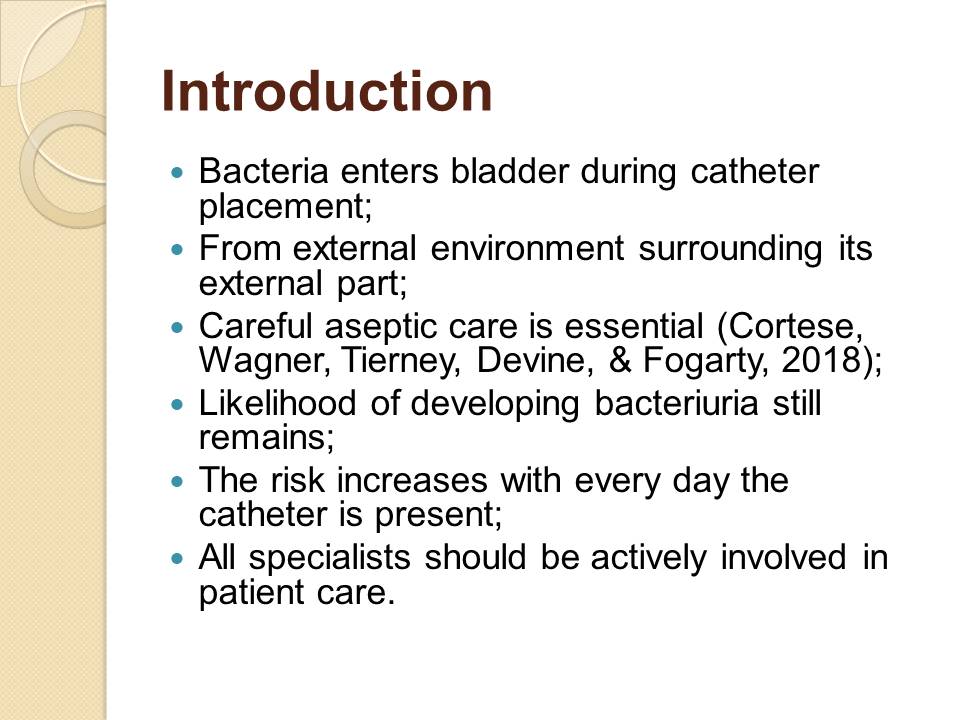
Assessment and Rationales
- National Patient Safety Goals 2019;
- NPSG.07.06.01: “Use proven guidelines to prevent infections of the urinary tract that are caused by catheters” (The Joint Commission Accreditation Hospital, 2019, para. 5);
- The problem is catheter-associated infections;
- Catheters are used for incontinence;
- Bags not drained frequently enough;
- Catheters not sterile when inserted.
A problem identified is associated with the NPSG.07.06.01 goal on catheter-associated infections of the urinary tract (The Joint Commission Accreditation Hospital, 2019). The first reason why the problem exists is the need to put a catheter for patients experiencing incontinence. The second problem is the fact that bags are not drained regularly enough resulting in a situation that they do not have enough empty room. The third rationale is the fact that catheters may not be clean during insertion.
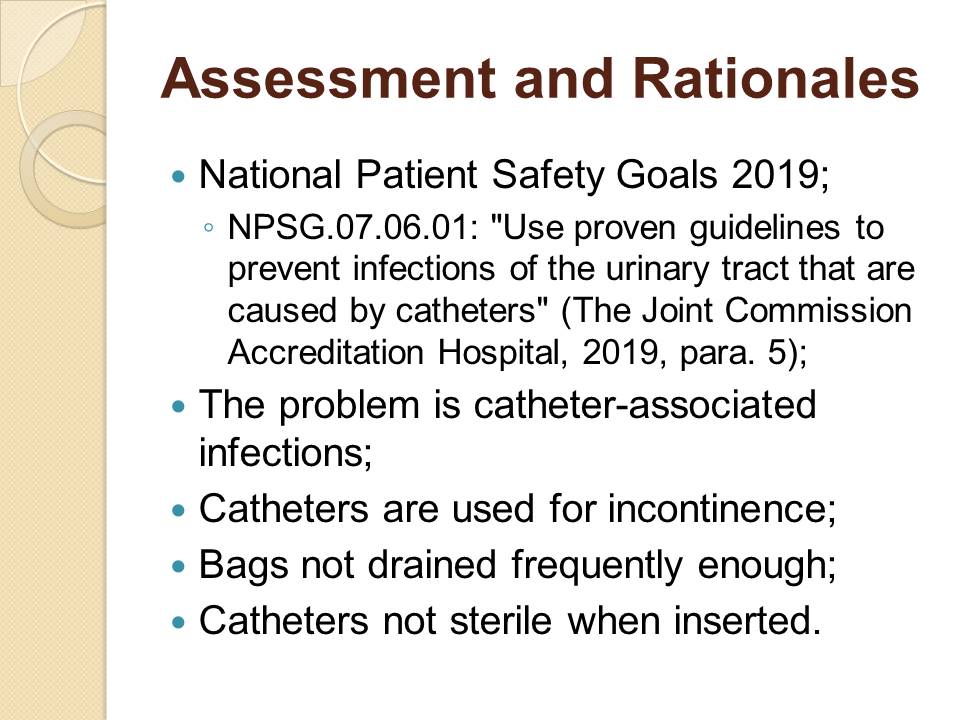
People Involved
- Doctors
- Recommending catheters when their use can be avoided;
- Not identifying specifically the number of catheters in place;
- Not warning nurse managers on infection prevention;
- Nursing personnel
- Not keeping track of catheters in place;
- Not sanitizing hands properly before inserting (Cortese et al., 2018);
- Negligence to disinfect catheters during every shift.
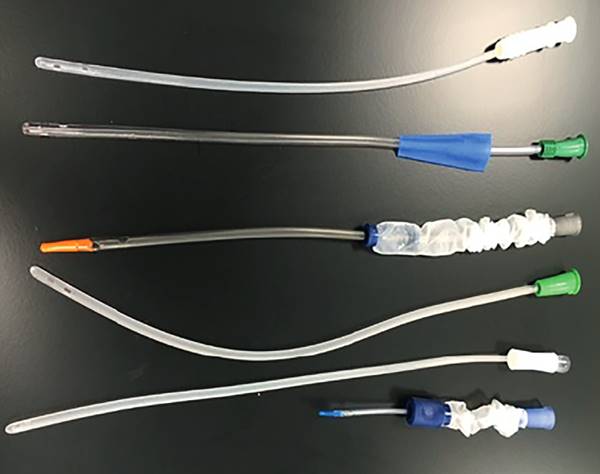
Doctors is the first group involved in the issue since they may instruct nurses to use catheters for patients who may not need those. Also, they may not specify the number of patients having catheters in place. Moreover, doctors do not warn nurse managers that they need to instruct nurses and nurse assistants on effective infection prevention (Cortese et al., 2018). The second group is nursing personnel who do not track patients with catheters and may neglect to sanitize their hands and catheters properly.

Solutions
- First solution – sanitizing hands before and after procedure;
- Second solution – emptying urinary bag more often;
- Third solution – tracking the number of days a catheter has been in patient’s body;
- The purpose of all solutions is to ensure adequate sanitizing;
- No additional costs associated with solutions (Ahmad, Abbas Anjum, Khan, & Naeem, 2018);
- Desired outcome for all three – lowered risk of urinary infection.
The first solution implies doctors and nursing personnel will keep their hands clean before and after inserting catheters. The second solution requires nurses to empty the urinary bags more often to ensure there is enough empty room. The third solution is recording the number of days a catheter has been in a patient’s body (Ahmad et al., 2018). All the solutions are preventive in character and require no additional costs.
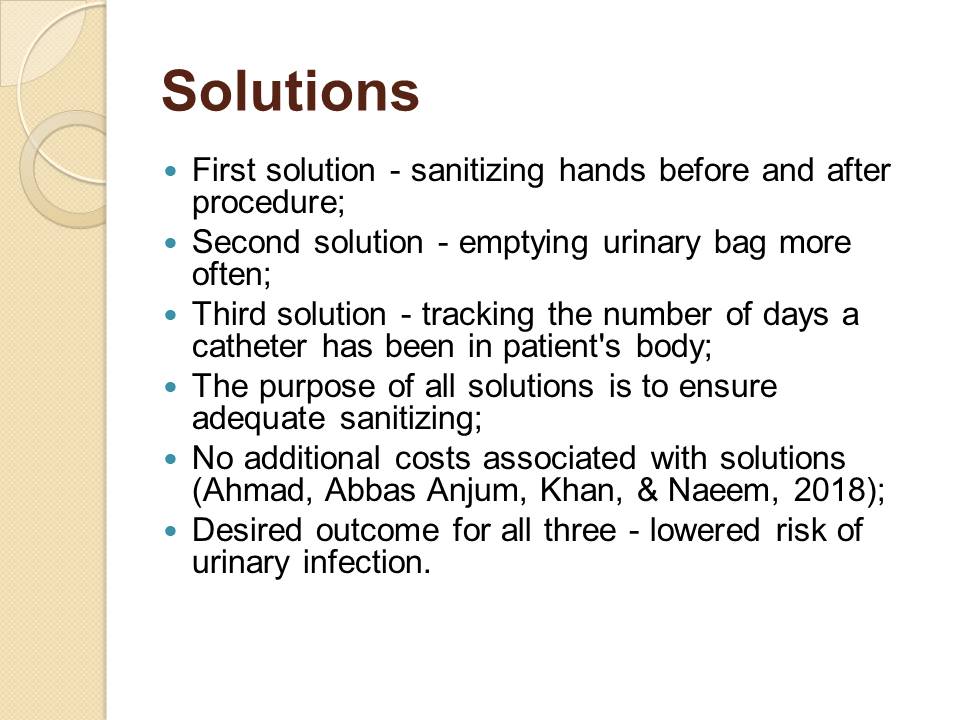
Chosen Solution and Explanation
- The chosen solution is tracking the number of days a catheter has been in a patient’s body;
- It encompasses such measures as hand and catheter sanitizing (Cortese et al., 2018);
- Therefore, it is more comprehensive;
- Will allow understanding the number of patients with catheters;
- Increase doctor and nurse awareness;
- Eliminate the possibility of negligence.
The solution to be shared with the director is tracking the number of days a catheter has been in a patient’s body. It implies that when the nurse notices the maximum time is approaching, they will essentially employ sanitation measures as well (Cortese et al., 2018). Also, if the number of days is tracked, this will allow tracking additionally the number of patients with a catheter in place. If days are tracked systematically, the possibility of negligence will be minimized.
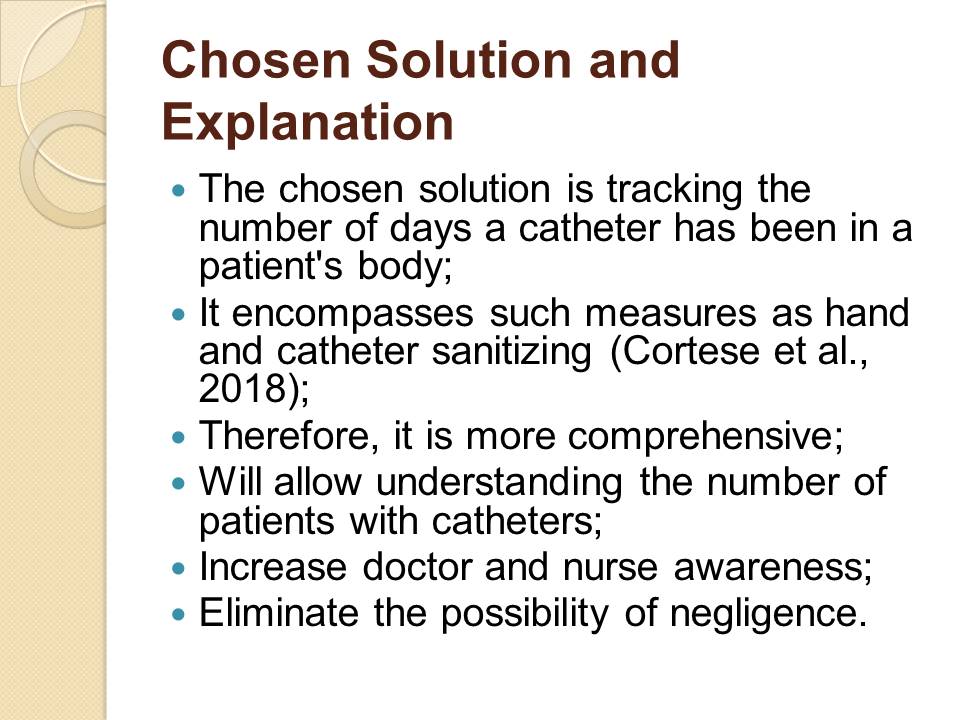
Action Plan
- Action plan includes several steps;
- Informing the director about the benefits of the solution;
- Instructing staff on the essential aspects;
- A sign with insertion date is placed outside (Ahmad et al., 2018);
- Current date is indicated as well;
- Nurses keep track of time adequate for keeping catheter;
- Nurses check clients who need to urinate.
The action plan for sharing the solution is carried out in several steps. Firstly, the director is informed of the possible patient outcomes if the solution is implemented. Secondly, the staff is educated on the revised method of handling patients. Thirdly, nurses start using a sign with insertion and current dates (Ahmad et al., 2018). They keep track of time for each patient individually and check with clients who need to urinate to provide timely care to them.
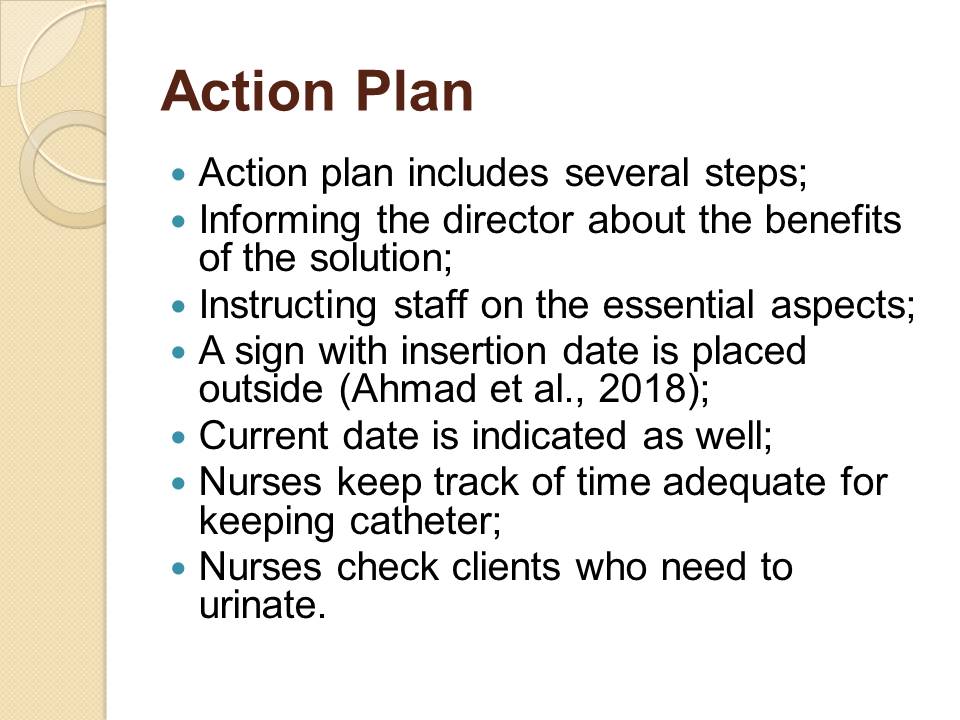
Summary
- The issue of catheter-associated infections is still relevant;
- To resolve it, nurses should be involved in patient care (Cortese et al., 2018);
- They should keep track of number of days a catheter is in place;
- Main patient outcome will be infection prevention;
- Quality improvement is essential for minimizing hospital costs due to effective prevention;
- Quality of patients’ lives will also be improved.
Thus, the issue of catheter-associated infections remains relevant to nursing practice. To resolve it, nursing personnel should be involved in patient care actively (Cortese et al., 2018). Specialists should keep track of time a catheter has been in a patient’s body. This will allow preventing infections emergence while minimizing hospital expenditures in the long-term. Moreover, the quality of patients’ lives will be improved due to effective healthcare and prevention.
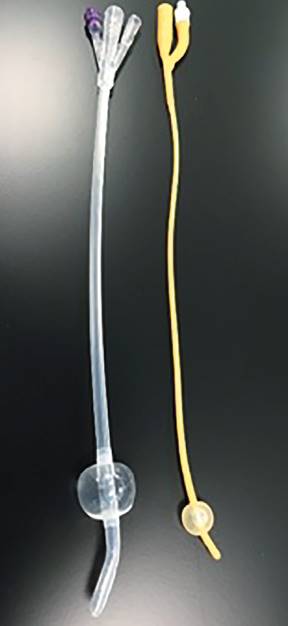

Reflection and Concluding Points
- Learned about catheter care and its importance;
- Learned about new preventive strategies;
- Understood the significance of doctor-nurse collaboration (Cortese et al., 2018);
- This presentation will educate other people on how infections can be prevented;
- Catheter-associated infections pose a serious threat to patient’s health;
- Effective prevention will allow for avoiding health complications.
This learning experience has been insightful due to the fact that it revealed a new perspective on preventive strategies in terms of catheter-associated infections. Doctors should collaborate with nurses actively to ensure urinary tract infections do not occur (Cortese et al., 2018). The value of this presentation lies in the fact that it will educate other people on ways to prevent such infections. In the long-term, effective prevention is the key to better patient outcomes and avoidance of serious health complications.
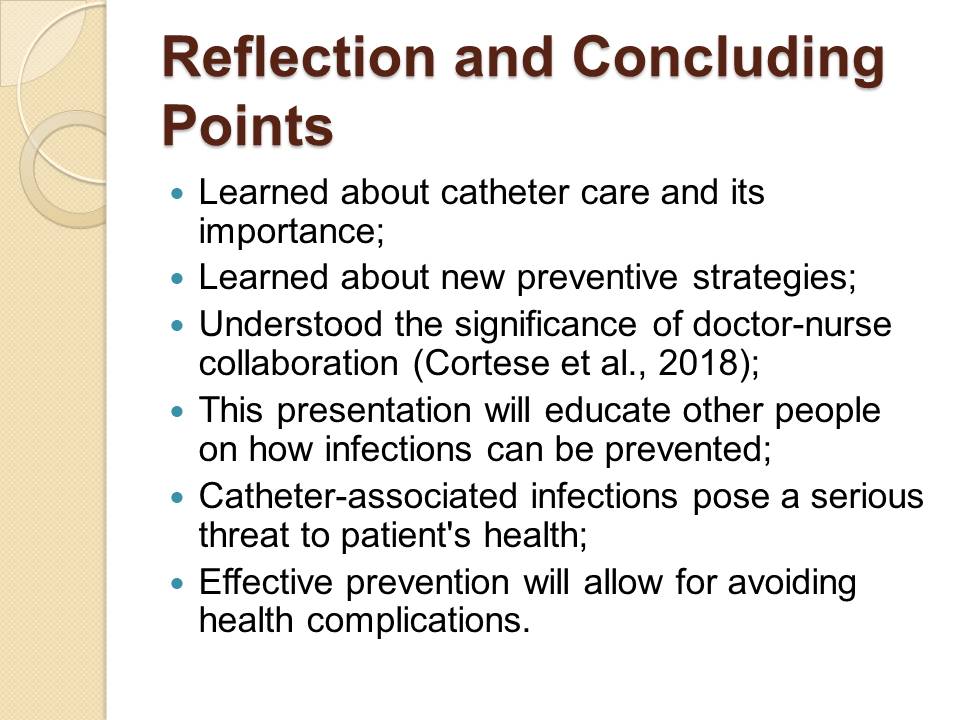
References
Ahmad, H., Abbas Anjum, H. M., Khan, M., & Naeem, A. (2018). Comparison of noble metal alloy coated urinary catheters with non coated catheters in reducing catheter-associated urinary tract infections. Isra Medical Journal,10(3), 134-137. Web.
Cortese, Y. J., Wagner, V. E., Tierney, M., Devine, D., & Fogarty, A. (2018). Review of catheter-associated urinary tract infections and in vitro urinary tract models. Journal of Healthcare Engineering,2018, 1-16. Web.
The Joint Commission Accreditation Hospital. (2019). Hospital national patient safety goals.